#clan cairngorm
Explore tagged Tumblr posts
Text
Unicorn Whisky 🦄 Myth or Reality?
Fettercairn 12 is a Highland single malt that was founded in 1824 and is one of the oldest licensed distilleries sits at the foot of Scotland's Cairngorm Mountains, in the Scottish Highlands, in the village of Fettercairn.
Fettercairn's logo is the first to feature a unicorn, Scotland's national animal, symbolising purity and strength. The "unicorn whisky" is Fettercairn, a distillery in Aberdeenshire, Scotland, known for its unicorn crest and distinct flavour profile. The unicorn on the bottle's label comes from the crest of the founder's clan.

What makes Fettercairn unique, the distillery attributes these notes to proprietary cooling rings that sit at the top of its stills, invented in the mid-1950s. They pour water over the still's neck to cool the copper. This helps create a lighter spirit and makes it unique. This technique is pretty rare in Scotland 🏴 like giving the still a refreshing shower!
Early Blended Scotch: In the early 1900s, Fettercairn's product was used to create the first blended Scotch whisky, Johnnie Walker, and has gone on to be used in other famous blends such as Whyte & Mackay and J&B Rare.
🥃 As for the taste, Fettercairn 12 offers a gentle palate with notes of vanilla and tropical fruits like coconut and pineapple. Its smooth , mild, unpeated character and easy-drinking nature make it an excellent choice for those new to single malt whiskies.
@fettercairnwhisky #whisky #ClanRamsay
Posted 9th April 2025

It's a fun bottle to have in a range of other 12 year old whiskies to offer up some contrast in your collection, if you are willing to spend a bit more money. I also like unicorns. 🦄
1 note
·
View note
Text
14Top Rated Tourist Attractions in Scotland
Scotland, which makes up the northern part of the United Kingdom, is a country of dramatic scenery and intriguing history and vibrant culture. Seven of them form part of an archipelago of more than 790 islands, most of the population, however, reside on the mainland, which can be divided into several regions: the Highlands, the Lowlands and the isles.
It is famous for its beautiful countryside and national parks, such as its expansive mountain ranges, including the Scottish Highlands, home to the United Kingdom’s highest peak, Ben Nevis. More cliffs, beaches, and lochs can be explored on the scenic coastlines, which also include the legendary Loch Ness, where a folk tale surrounding the Loch Ness Monster continues to captivate locals and travelers alike. The Cairngorms National Park’s vast open wilderness is a park for hikers, skiers, and wildlife spotters.
Scotland’s lore is suffused with stories of warriors, clans and kings. Landmarks like Edinburgh Castle and Stirling Castle being historic bastions of military power reflect the country’s tumultuous history, and sites like Culloden Moor memorialize the Jacobite uprisings. Edinburgh (capital) The Royal���Mile, which stretches from the stunning Julius Julius Julius Caesar Castle to the Royal Residence Holyrood Palace, has ruled over the UNESCO World Heritage Site for thousands of years (Edinburgh City). Edinburgh is also well-known for its festivals, such as the Edinburgh Festival Fringe, the world’s largest arts festival.
Scots are also proud of their heritage of these cultures and Scots today are flanked by the cultural spectacle of bagpipes and kilts and the Highland Games. Scotland has a literary tradition as rich as Robert Burns, Sir Walter Scott and J.K. Rowling. Scotland (News – affiliate link) offers an unforgettable experience for any traveler, whether you’re visiting its stunning natural beauty, historical landmarks or cultural wealth.more details.....Scotland 14Top Rated Tourist Attractions in Right now
0 notes
Text
Chapter Thirty-Nine
The Dreamwalker
1485 DR / Day 41
Laduguer’s Furrow, Gracklstugh
The sad pattern continued as Zelyra, Kazimir, and Prince Derendil made their way westward to Cairngorm Caverns. Destruction, death, silence, fear… The once bustling city of Gracklstugh was rank with it. What should have been a ten-minute walk quickly tripled due to the damage the red dragon, Themberchaud, had wrought.
And yet, there was one bright spot amidst the fallout—
Gracklstugh was already starting to rebuild.
The petty war that had broken out between clans was forgotten. Duergar, who had been at each other’s throats, needlessly spilling blood mere hours before, now rallied together and stoically worked side by side to put out fires, clear the streets, and search for trapped victims. The trio did what they could to help along the way, which slowed them even further.
As they navigated the wreckage of the southern housing district, Zelyra’s sharp eyes fell upon a figure lying near a collapsed building. The druid gasped and rushed forward. Derendil and Kazimir hurried after her. The body that Zelyra had found was none other than Grinta Ironhead.
Not only had Grinta been one of the co-conspirators of Blackskull’s coup—she was Laird Thangus Ironhead’s only daughter. [1] The once proud and fierce weaponsmith now looked so small and fragile, her armor cracked and scorched. Further search revealed Grinta’s honor guard trapped among debris. The elderly priest who presided over their Heroes’ Feast was also there. He lay flat on his back, his dark eyes trained upwards, lifeless and unseeing.
They had never asked the priest’s name, let alone thanked him for the powerful adjuration magic that had undoubtedly saved their lives in the throne room…
And now they never could.
“How did it come to this?” Kazimir muttered.
“Pride was allowed to override reason,” Prince Derendil replied, his head downturned. “No side would have come out of the coup without substantial loss. But they knew that, I think. Blackskull, Amber, Grinta, and the other lairds who sided with them… Themberchaud knew it, too. That’s why he chose to attack when he did. It was his best and only chance. This was a battle that neither side could have won.”
“They didn’t deserve this,” Zelyra said as she dropped to her knees beside the priest and reached out with trembling fingers to close his unseeing eyes in respect. “None of them did,” the druid muttered. She then brought her hands to her mouth in a gasp. “Poor Blackskull! She must—”
Zelyra left the conclusion of ‘guilt’ unsaid.
But both of her companions knew what she meant.
“Yeah,” Kazimir breathed.
The wizard reached into the pocket of his robes for the small, polished stone that connected him to Captain Errde Blackskull. He hesitated, his thumb rubbing its smooth surface before relaying the news and location of the bodies. Blackskull’s response was swift and clipped, but the tiefling could tell it significantly weighed on her.
“I will send a recovery team immediately.”
There was a slight pause, and then—
“Thank you for letting me know, Kazimir,” the duergar said softly. “Stay safe. We’ve lost too many already.”
Not for the first time, the tiefling wizard warred with himself internally. Surely, they could have done something more. Or perhaps they should have done the opposite and turned their backs on Blackskull, washing their hands of the duergar city altogether when they had the chance. But a nagging voice in Kazimir’s subconscious that sounded suspiciously like Fraeya argued that Gracklstugh would have been worse off had they done that. If they had not exposed Shal, if they had not broken the succubus’s hold and returned Deepking Horgar to his right mind—
Themberchaud’s attack would have devastated the City of Blades.
And that effect would not have been limited to Gracklstugh. Had the duergar city fallen to the dragon, it would have had untold consequences on the entire trade infrastructure of the Underdark.
“Any news of Amber Thrazgad’s whereabouts?” the wizard finally asked.
“None,” the captain replied curtly.
The link between the sending stones fell silent.
Kazimir sighed. It was strange, given that their interaction with the head of Clan Thrazgad had been limited to just a few short meetings, but the tiefling felt as though a rock had settled in the pit of his stomach. Had the fiery armorsmith met the same fate as Grinta Ironhead?
The wizard took another deep breath and then released it. Around them, the duergar continued their grim work, cleaning the streets and tending to the wounded. There was resilience to them, some stubborn determination to keep going despite all odds. Kazimir had come to respect it during their time in the city. They might not see eye to eye on specific policies—the slave trade, for one—but these were a people who had built their lives in the harshest of environments, who had carved out a place for themselves in the unforgiving Underdark. They would survive this, somehow.
. . . Read more: https://archiveofourown.org/works/35100307/chapters/152830810
#out of the abyss#dungeons and dragons#the grey warriors#dnd#druid#ranger#fiction#zelyra erenaeth#kazimir oussnddare#balasar#fraeya#eldeth feldrun#prince derendil#sarith kzekarit#fargas rumblefoot#gracklstugh#revised gracklstugh#stool#rumpadump#captain errde blackskull#the deepking#themberchaud#stoneguard#stonespeaker hgraam#rihuud#stone giants#cairngorm caverns#stonespeaker crystal#ritual#feywild
0 notes
Text
Laird Hasenbär in Schottland - Tag 18
Lairds and Ladies!
Heute verlassen wir unser Cottage in Inverness und damit auch die schottischen Highlands.

Wir folgen zunächst der Highland Tourist Route an der Küste entlang, in Richtung Aberdeen, biegen dann aber in den Cairngorms National Park ab.

Der Nationalpark wurde 2003 offiziell als Park gegründet. Mit 1.467 Quadratmeilen ist er Großbritanniens größter Nationalpark. Der Park hat ein großes Hochplateau und ist als „geschützte Landschaft“ eingestuft.
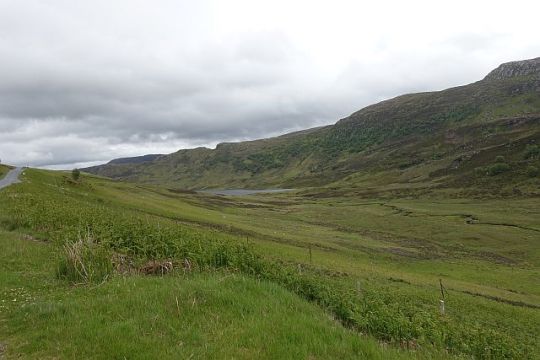
Neben den Bergen sind die alten kaledonischen Wälder wahrscheinlich das auffälligste Merkmal der Cairngorm-Landschaft. Diese Jahrhunderte alten Wälder liegen um abgelegene Seen herum oder säumen spektakuläre wilde offene Moorlandschaften.
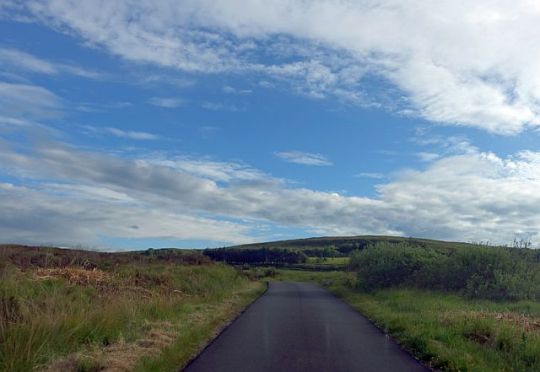
Der Tourismus ist ein wichtiger Teil der Wirtschaft des Cairngorms-Nationalparks, und seine Gemeinden sind bestrebt, Besucher anzuziehen.
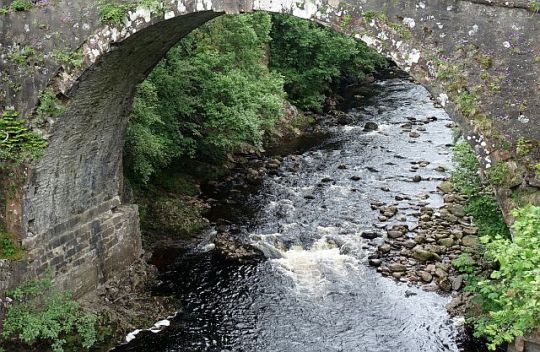
Wir biegen noch einmal ab und fahren in die Region Speyside. Diese Region ist nach dem Fluss Spey benannt. Das fruchtbare Tal rund um diesen Fluss ist heute das Herzstück der schottischen Single-Malt-Whisky-Produktion.
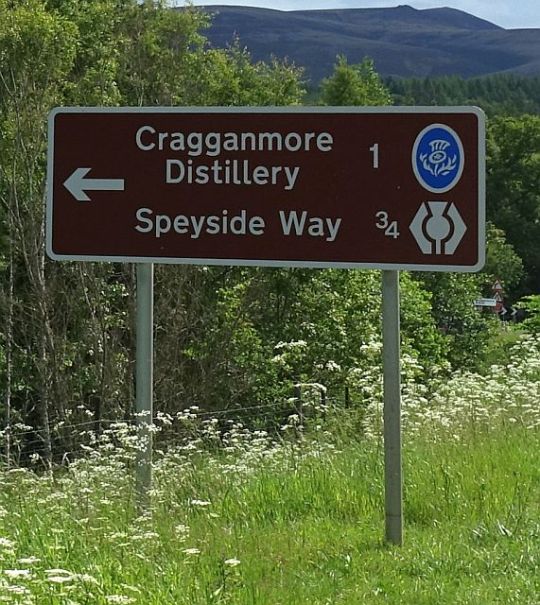
Als hier die ersten Whiskys hergestellt wurden, war dies ein illegaler Handel. 1822 unternahm König Georg IV. eine Reise nach Speyside, wo er angeblich einen dieser illegalen Whiskys probierte.
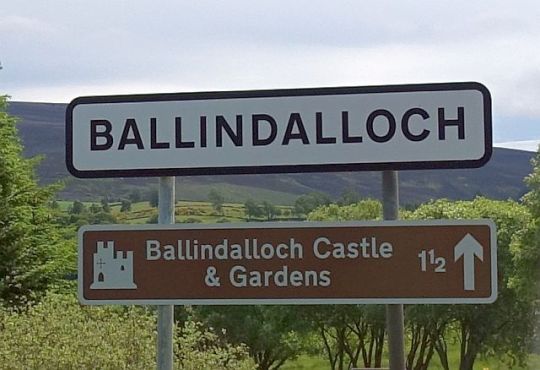
Nach seinem Besuch wurden nach und nach immer mehr Lizenzen für Destillerien vergeben, wodurch der schottische Single Malt Whisky aus der Speyside zu seiner Bekanntheit kam.
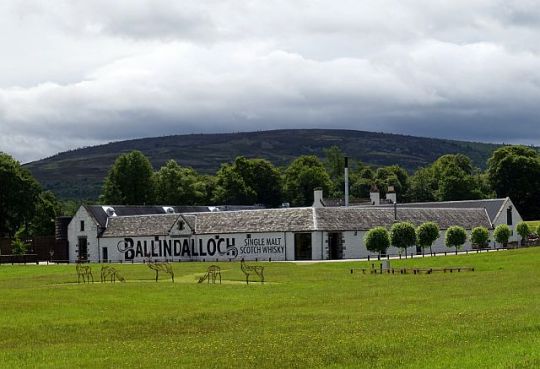
Heute sind die Speyside-Brennereien weltweit anerkannt. Einige der bekanntesten Whisky-Marken werden in der Gegend hergestellt, aber auch eine große Anzahl weniger bekannter Destillerien kann man in Speyside besuchen.

Immerhin wird die Hälfte des schottischen Single Malt Whiskys in diesem Gebiet produziert. Der Whisky Trail führt quer durch Speyside und somit an einer Vielzahl von Destillerien vorbei.
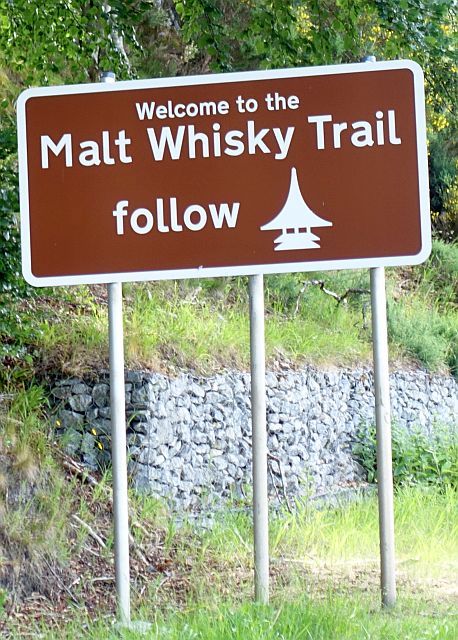
Leider ist der heutige Tag als reiner Transfer geplant. Wir wollten unseren Zeitplan nicht zu sehr vollpacken, da wir mit unserer nächsten Unterkunft ein Eintreffen zwischen 16 und 17 Uhr vereinbart hatten.

Am Ende verfährt man sich oder es tritt ein unvorhergesehener Zwischenfall ein - und dann steht man da. So bleiben eventuelle Castle Besichtigungen und Whisky Tastings außen vor.
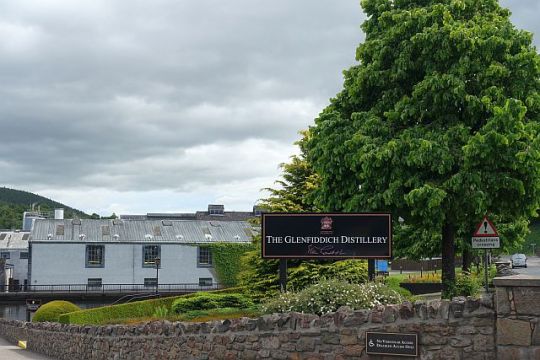
Durch puren Zufall kommen wir an dem Clan Grant Centre vorbei. Dieses ist die Heimat der Clan Grant Society Worldwide, in der alten Kirche von Duthil, in der Nähe von Grantown-on-Spey.

In ihren Anfängen gehörte die Kirche zu der Diözese Elgin Cathedral. Der erste presbyterianische Geistliche war Andrew Henderson, der 1625 ordiniert wurde. Das heutige Gebäude wurde 1826 errichtet.

Das Gebäude befindet sich inmitten der Clan-Territorien und es gibt Grund zu der Annahme, dass es wahrscheinlich kurz nach 1060 von dem Patriarchen Olav Hemingsson selbst gegründet wurde. Die ursprüngliche Widmung ist St. Peter und der Name Duthil für das Gebiet Mai beziehen sich gut auf St. Dubhthac.
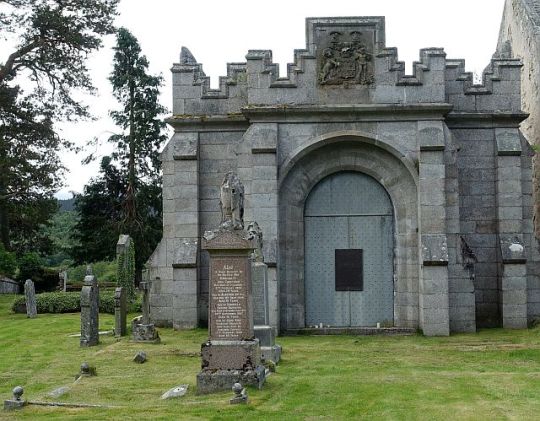
Auf dem Kirchengelände befinden sich zwei Mausoleen, in denen einige der Clan Chiefs begraben sind.
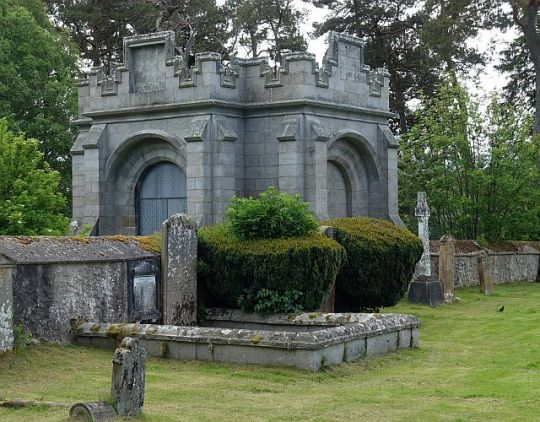
Wir erreichen die Ostküste in der Region Aberdeen und fahren hier die Küstenstraße in Richtung Süden, in den Ort Stonehaven.

Stonehaven (Steenhive, gälisch Cala na Creige - im Volksmund oft Stoney) liegt an den wichtigsten Straßen- und Eisenbahnstrecken, knapp 25 Km südlich von Aberdeen.
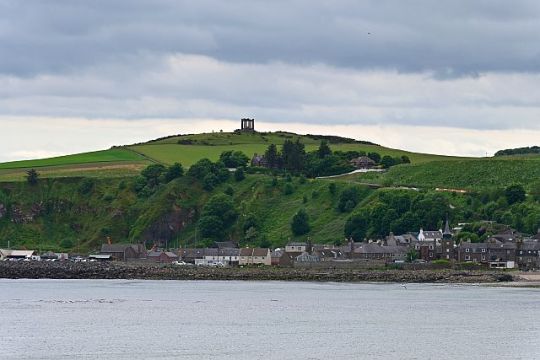
Die Lage von Stonehaven ist ausgezeichnet. Stonehaven befindet sich in geschützter Lage in der Stonehaven Bay zwischen dem Carron und dem Cowie, die Begrenzungspunkte der Bay sind die Klippen von Downie Point und Garron Point/Bellman's Head.
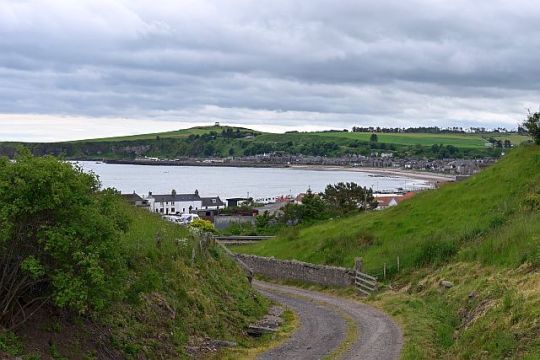
Höheres Gelände sowohl im Norden als auch im Süden erzeugen das Gefühl eines Amphitheaters und bietet eine gute Aussicht über die Stadt, egal aus welcher Richtung man sich nähert.
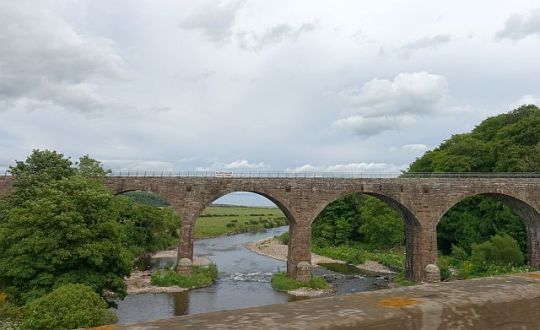
Die Eisenbahn südlich von Aberdeen überquert den Fluss Cowie über das 50 m hohe Glenury-Viadukt, bevor sie den Bahnhof Stonehaven am Westrand der Stadt erreicht.
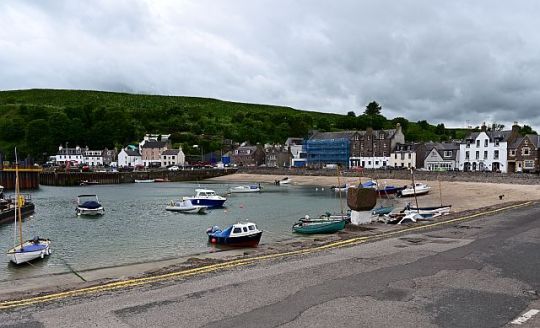
Die umgebende Anhöhe bietet Stonehaven auch einen gewissen Schutz vor den vorherrschenden Westwinden, während die Hafenmauern dazu beitragen, einen ähnlichen Schutz vor den Launen der Nordsee zu bieten.
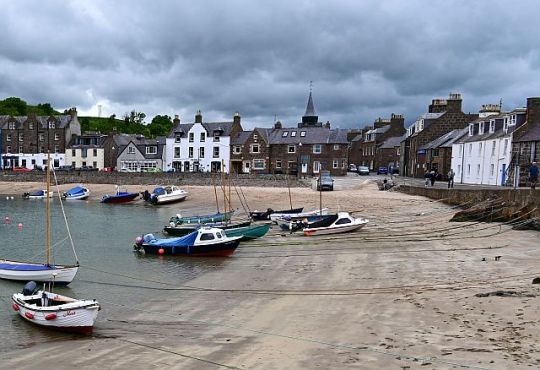
Wie für viele Orte entlang der Küste war auch für Stonehaven der Hafen immer von großer Bedeutung. Im 15. Jahrhundert wurde hier bereits erstmals ein Wellenbrecher gebaut und um 1600 wurde das Tolbooth Gefängnis, heute ein Museum, aus einem früheren Getreidelager umgebaut.
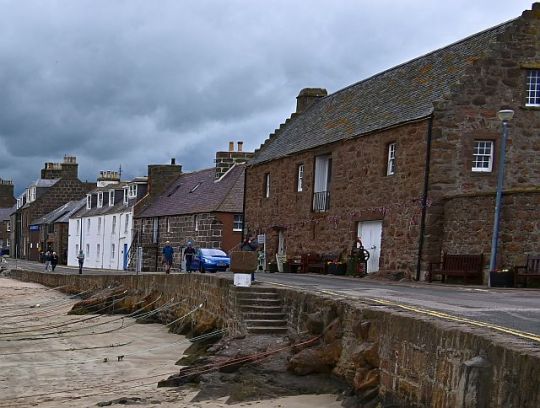
Der ursprüngliche Hafen wurde immer wieder durch Sturmfluten zerstört. Um 1678 verstärkte man den Hafen, dennoch wurden die Anlagen erneut durch Sturmfluten zerstört. In den folgenden Jahrhunderten fanden weitere Hafenbauten statt. Um 1825 übergab man dem erfahrenen Ingenieur Robert Stevenson (aus der berühmten Stevenson Familie) die Planung eines neuen Hafens, bis heute der einzige sichere Hafen entlang dieser gesamten Küste bei einem Nordoststurm.
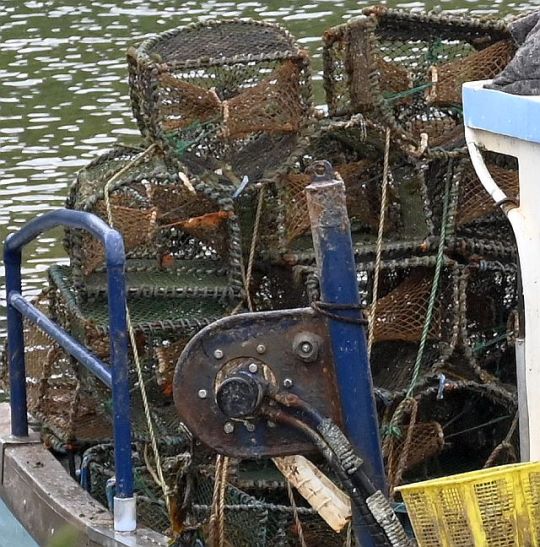
Einst war die Fischerei der wichtigste Erwerbszweig für die Menschen in Stonehaven. Vor allem Hering wurde hier im Hafen umgeschlagen. Bis zur Jahrhundertwende um 1900 waren angeblich weit über 1000 Menschen in der Fischerei beschäftigt und im Hafen schlug man jährlich bis zu 15 Millionen Fische um.

Allerdings traf auch Stonehaven die Überfischung und Globalisierung relativ hart. Um die Zeit des II. Weltkriegs waren kaum noch Menschen in der Fischerei tätig. Gefangen wurde praktisch nur noch für den Eigenbedarf.

Stonehaven Harbour ist heute einer der größten Freizeithafen in Aberdeenshire und der Hafen gehört zu den zentralen Punkten im Ort. Es gibt insgesamt drei Hafenbasins mit insgesamt ca. 18.200m². Der Hafen ist zudem recht gut belegt, im Schnitt sind alle 140 Anlegestellen besetzt. Normalerweise muss man auf eine Warteliste, wenn man sein Boot in Stonehaven dauerhaft festmachen will.
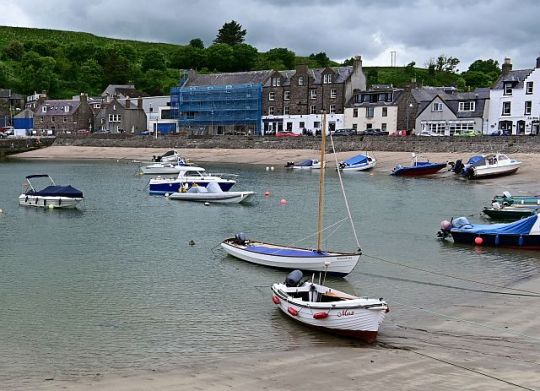
Der historische Mittelpunkt von Stonehaven ist natürlich sein Hafen und die dahinter liegende Altstadt. Das Ship Inn wurde 1771 mit Blick auf den Hafen erbaut und ist älter als das Town House mit seinen spitzen Türmen, das erst 1790 erbaut wurde.
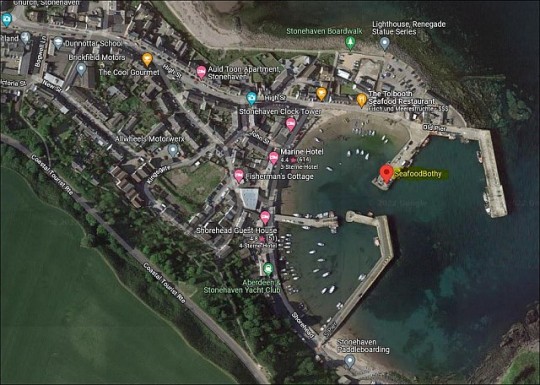
Die Hauptdurchgangsstraße von Stonehaven, die Allardyce Street, verläuft dicht hinter der Promenade und dem Strand von Stonehaven Bay. In der Mitte befindet sich der Marktplatz und am Pier soll sich eine legendäre Fischbude befinden.
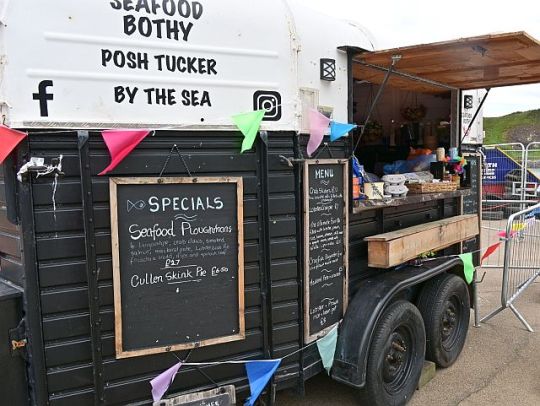
The Seafood Bothy ist eine Fischbude am historischen Hafen von Stonehaven und serviert frische Meeresfrüchte direkt aus den Fischernetzen. Das Originelle daran ist, dass die Bude in einem alten, umgebauten Pferdehänger untergebracht ist.

Hummer, gefüllte Baguettes, Meeresfrüchte-Nachos, Makrelenpastete – bei den ständig wechselnden wöchentlichen Specials ist alles zu haben. Für uns gibt es nichts Schöneres, als an der Küste zu essen. Endlose Weitblicke und eine frische Brise um die Nase.
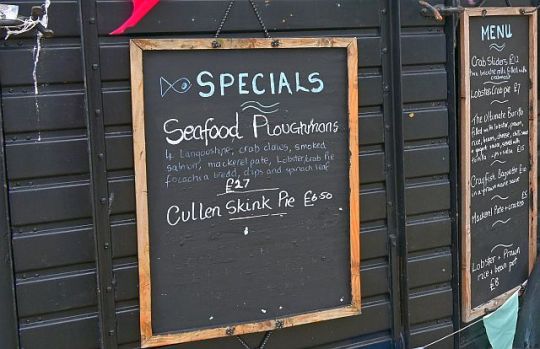
Leider finden am Pier gerade umfangreiche Bauarbeiten statt. Deswegen verfügt die Fischbude gerade über keinerlei Sitzmöglichkeiten. Die Bedienung erzählt uns, dass man den Pferdeanhänger eigentlich, für die Dauer der Arbeiten, ebenfalls hier weg haben wollte. Man habe sich aber durchsetzen können, da das Hauptgeschäft eben im Sommer stattfindet und man nicht auf die Beendigung warten könnte, dann wäre man nämlich pleite.

So nehmen wir unsere beiden Fischplatten mit und wollen uns weiter oben eine Sitzgelegenheit mit Meerblick suchen. Die Damen vom Grill der Fischbude packen uns freundlicherweise Holzbesteck, Servietten und Reinigungstücher ein und wir ziehen mit unserer leckeren Beute los ...
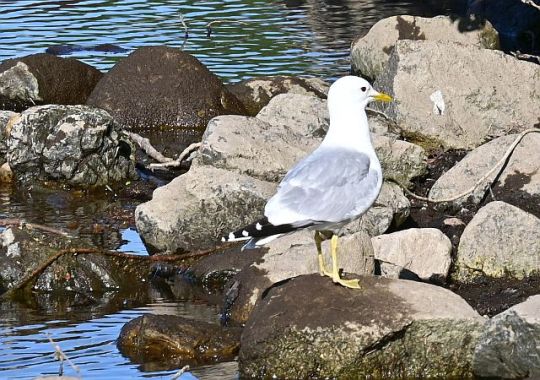
... unter dem wachsamen Auge diverser Vögel, die längst mitbekommen haben, dass sich hier potentielle Opfer auf den Präsentierteller begeben.
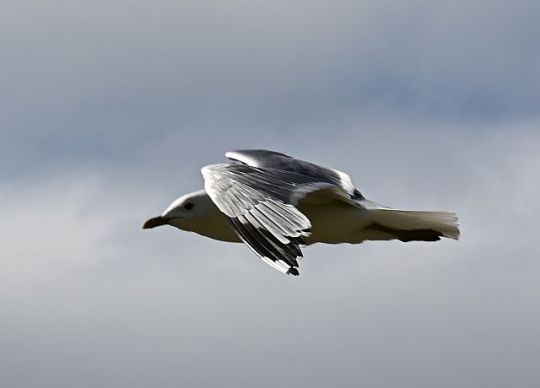
Was wiederum von uns nicht unbemerkt blieb - und so setzen wir uns, sehr zum Ärger der Möwen, einfach ins Auto.
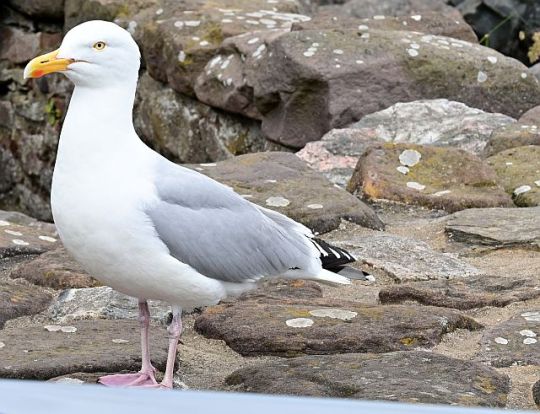
Wer einmal den alten Hitchcock Klassiker “Die Vögel” nachstellen möchte, dem können wir diese raffinierte Taktik wärmstens empfehlen.
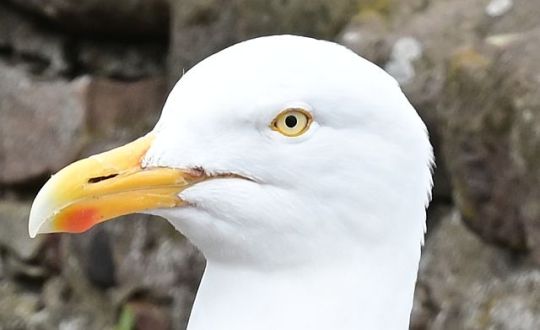
Man glaubt es nicht, die großen Sea Gulls attackierten doch tatsächlich das Auto: setzen sich auf die Motorhaube, hackten in die Windschutzscheibe und in die Scheibenwischer ...
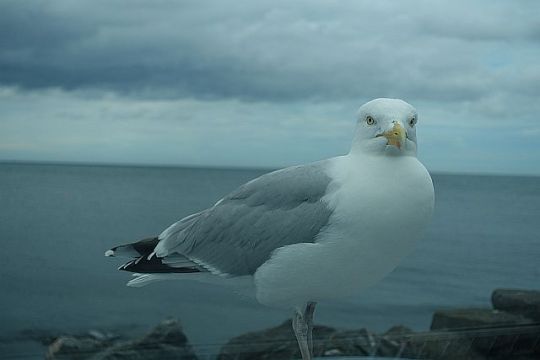
Da blieb manch ein Passant stehen und wunderte sich, was da wohl vor sich gehen mag.

Wir schaffen es nicht beide Seafoodplatten zu vernichten, so packen wir die zweite Platte ein, stellen sie in unsere Kühltasche und machen uns wieder auf den Weg in Richtung Süden.
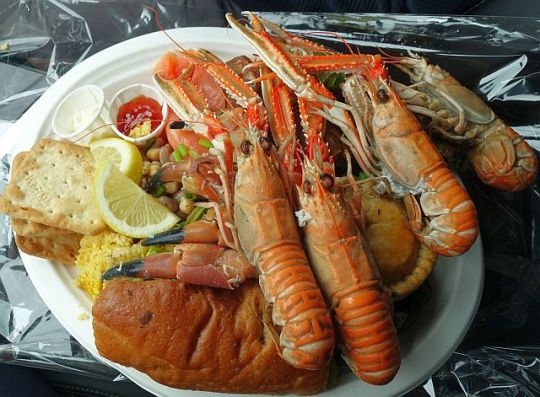
Wir fahren dabei immer möglichst nah an der Küste entlang. Es ist eine tolle Landschaft und wir entdecken dabei so manchen Kleinod.
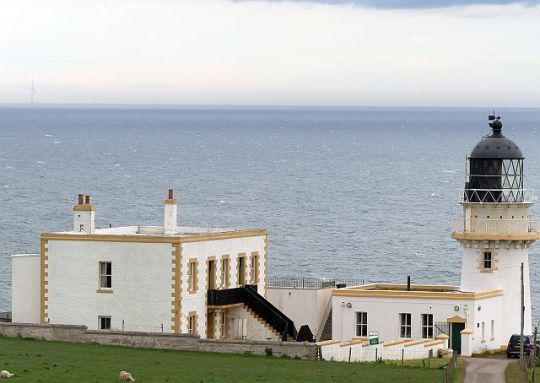
Beispielsweise eine interessante Immobilie: Wer schon immer einmal einen Leuchtturm sein Eigen nennen wollte, hat hier die einmalige Gelegenheit zuzugreifen.
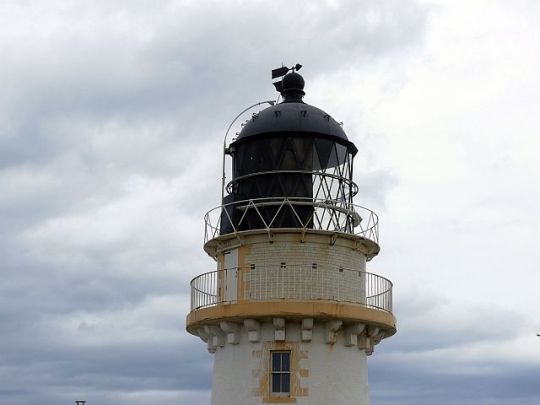
Die Bausubstanz macht noch einen guten Eindruck - sagt der Experte, der neben mir im Auto sitzt.
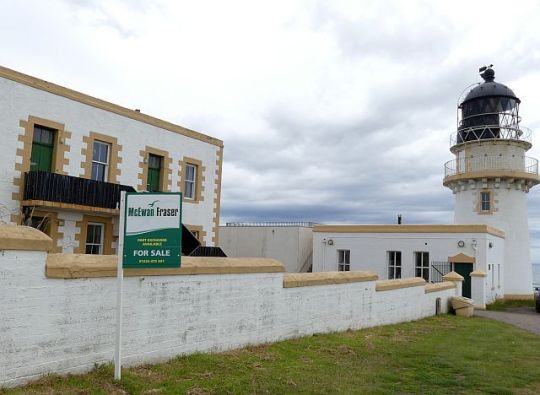
Der Blick ist sensationelle, die Lage könnte jedoch auf Dauer etwas einsam sein. Das muss man schon sehr mögen ...
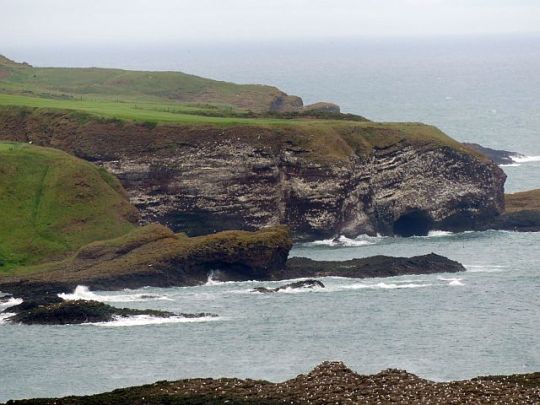
... dafür sind die Nachbarn ausgesprochen pflegeleicht.
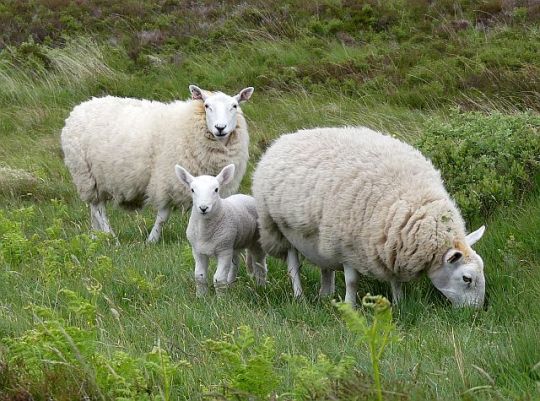
Um 16.30 Uhr treffen wir an dem Haus in dem sich unsere Suite - die sich als ganzes Appartement entpuppt - ein. Die Housemaid ist noch nicht mit der Reinigung fertig und bittet uns um eine halbe Stunde Geduld.

Zum Glück ist sie noch in der Suite beschäftigt, denn mit dem Selbst-Check-In und diesem ganzen neuzeitlichen Gedöns, sind wir schon wieder völlig überfordert:
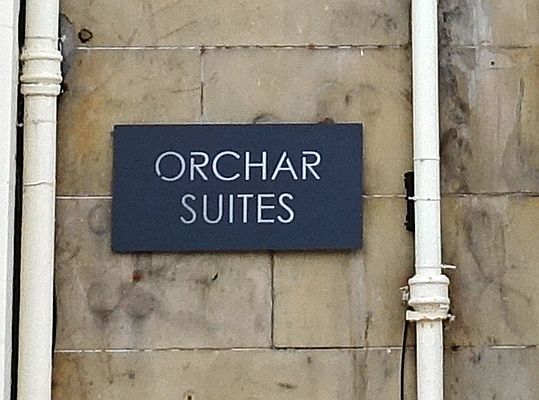
Hand auf den Screen legen, die 10-stellige Nummer eintippen plus Sternchentaste am Ende, dann den Griff so rum und so rum drehen, damit man überhaupt erst einmal in den Flur kommt. Dort dann den Zahlencode am Schlüsselfach eingeben, um den Wohnungsschlüssel zu entnehmen - und dann kann man endlich .... Trommelwirbel ... in das Appartement.

Das Abendessen war ja zum Glück gesetzt: es gab völlig unerwartet und überraschend Fischplatte!
Oidhche mhath!
Angie, Micha und Laird Hasenbär
9 notes
·
View notes
Video
The Gatehouse - Ardverikie House by FotoFling Scotland Via Flickr: Ardverikie House is a 19th-century Scottish baronial house in Kinloch Laggan, Newtonmore, Inverness-shire, Scottish Highlands. The house was made famous as the fictional Glenbogle estate in the BBC series Monarch of the Glen. The lands historically belonged to Clan Macpherson. The 20th chief, Ewen Macpherson, leased Benalder and Ardverikie in 1844 to The 2nd Marquess of Abercorn, an Ulster-Scots peer, "one of the trend setters in the emerging interest in deer stalking in Scotland." The Marquess expanded the original shooting lodge. He served as Groom of the Stool to Prince Albert, husband of Queen Victoria, who along with the prince spent three weeks at Ardverikie in the late summer of 1847. In 1860, Lord Abercorn transferred the lease to Lord Henry Bentinck, another stalking enthusiast, who lived there until his death in 1870. Sir John Ramsden purchased the Ardverikie and Benalder forests in 1871 for £107,500 (equivalent to £10,083,219 in 2019). In 1873, the house was destroyed by fire, and was rebuilt from 1874 to 1878. It was rebuilt in the popular style of Scottish baronial architecture, designed by the architect John Rhind. Ramsden's son, Sir John Frecheville Ramsden, inherited the lands after his father's death in 1914. The majority of the land was sold off following the two World Wars, and in 1956 Sir John transferred the Ardverikie Estate to a family company under the chairmanship of his son, Sir William Pennington-Ramsden. The company, Ardverikie Estate Limited, still owns and manages the estate today. The estate does business renting cottages and letting the property for weddings. Filming location Ardverikie House and its estate have been used as a location for filming. It is most recognisable as the Glenbogle Estate in the BBC series Monarch of the Glen, that ran for seven series from 2000 to 2005. It was also used in Miss Marple: A Murder is Announced (1985), the films Mrs Brown (1997), Salmon Fishing in the Yemen (2011), and Outlaw King (2018). The estate has been featured in the series Outlander, and in the first, second, & fourth seasons of the Netflix drama The Crown, standing in for the Balmoral Estate. During summer 2019, filming of No Time to Die was taking place in the town of Aviemore and the surrounding Cairngorms National Park with some scenes shot at the Ardverikie Estate. In October 2020 filming for the The Grand Tour special "Lochdown" took place at Ardverikie House, with presenters Jeremy Clarkson, Richard Hammond, and James May staying the night on the estate. [wikipedia]
#Scottish#highlands#scotland#film/tv#location#gatehouse#Ardverikie#House#The Crown#Monarch of the Glen#flickr
8 notes
·
View notes
Text


Rangers in the Cairngorm Peaks have reported that the Stonemarch orcs have been showing a resurgence in activity the past few months. The Stonemarch have a long history of warfare against the Vale, seeking to conquer the territory for their leaders and gods, and the news coming in is not encouraging. Ninety years after the last invasion the Vale is not prepared to fend off another yet.
Clan Bloodspear appears to be the center of this new army. The clan has a long history of powerful leaders and warriors, and have never wavered in their dedication to destruction, rebuilding again after each defeat to try and bring glory to their cause.
Grenadiers are a testament to the threat that Clan Bloodspear could present. Far from the primitive and barbaric reputation the Stonemarch has, they have a great understanding of metalworking, alchemy, and even magic. Grenadiers are a force of specialists, armed with carefully crafted fire bombs to blast open holes in the enemy lines.
Originally from the 4e Monster Vault: Threats to the Nentir Vale. This post came out a week ago on my Patreon. If you want to get access to all my monster conversions early, as well as a copy of my premade adventure Experiment X63L, consider backing me there!
5th Edition
Bloodspear Grenadier Medium humanoid (orc), chaotic evil Armor Class 15 (leather armor) Hit Points 75 (10d8 + 30) Speed 30 ft. Str 12 (+1) Dex 18 (+4) Con 16 (+3) Int 15 (+2) Wis 12 (+1) Cha 10 (+0) Skills Investigation +4, Nature +4 Senses darkvision 60 ft. passive Perception 11 Languages Common, Orc Challenge 2 (450 XP) Special Equipment. The grenadier is equipped with 3 fire bombs and one bag of caltrops. Actions Dagger. Melee or Ranged Weapon Attack: +6 to hit, reach 5 ft., or range 20/60 ft., one target. Hit: 7 (1d6+4) slashing damage. Caltrops. The grenadier scatters a bag of caltrops over a square area that is 5 feet on a side. Any creature that enters that area must succeed on a DC 15 Dexterity saving throw or stop moving that turn and take 1 piercing damage. Taking this damage reduces the creature's walking speed by 10 feet until the creature regains at least 1 hit point. A creature moving through the area at half speed doesn't need to make the save. Throw Fire Bomb. The grenadier throws a firebomb onto a spot on the ground within 50 feet of it. The firebomb detonates, and each creature within 5 feet of it must make a DC 13 Dexterity saving throw, taking 10 (3d6) fire damage on a failed save, or half as much damage on a success. If the saving throw fails by 5 or more, the creature catches fire; until someone takes an action to douse the fire, the creature takes 5 (1d10) fire damage at the start of each of its turns. Flammable objects in the area that aren't being worn or carried ignite. Reactions Blaze Of Glory. When the grenadier is reduced to 0 hit points and there's at least one hostile creature within 5 feet of it, it detonates all its remaining fire bombs centered on itself.
13th Age
Bloodspear Grenadier 3rd level archer [humanoid] Initiative: +5 Vulnerable: Fire Handaxe +7 vs. AC - 8 damage Natural Even Hit: The grenadier recharges one use of fire bomb. Thrown Weapon: The grenadier can use handaxe to make a ranged attack against a nearby enemy. R: Fire Bomb +7 vs. PD (1d3 nearby enemies in a group, also targets the grenadier’s allies engaged with the targets) - 6 fire damage, or 3 fire damage to the grenadier’s allies Limited Use: 2/battle. C: Caltrops +7 vs. PD (all enemies engaged with the grenadier and 1d2 additional nearby enemies in a group) - 4 damage, and when the target tries to move it must make a saving throw. On a failure, the target takes 2 damage and it can’t move. The target gains a +5 bonus to the save if it doesn’t take a standard action on the same turn. Once the target successfully moves, this effect ends Effect: The grenadier pops free from all enemies when it uses this attack. Blaze of Glory: When the grenadier drops to 0 hit points, it can make one fire bomb attack. AC 19 PD 17 MD 13 HP 45
#D&D#dnd#dungeons and dragons#5th edition#13th age#homebrew#my homebrew#monster#NPC#humanoid#long post
32 notes
·
View notes
Photo

JAE
POND LIFE
Goodspeed’s lines and colors are so simple that one might think, “Well, I could’ve done that.” Even if one has and I just didn’t realize it, everyone’s still lucky that this slim guide to life exists. Charm everyone with Goodspeed’s pithy observations on pressing realities like time, productivity, haircuts, too-memorable TV commercials, and plant care.
WILLIAM SHAKESPEARE X MARCEL DZAMA: A MIDSUMMER NIGHT’S DREAM
A full Dzama monograph would’ve been lovely, but we’re probably OK with reading words, too? Forget scholarly annotations; (re-)contextualize Shakespeare’s lines with Dzama’s shimmering colors and bold lines. Feed everyone’s inner theater kid and help yourself, friends, and family create new connections with part of the literary, poetic, and theatrical canon.
A CARNIVAL OF SNACKERY
I grew up listening to This American Life, and the Davids pretty much live in my brain, especially during the holidays. Who wouldn’t enjoy tucking into Sedaris’s takes on life as a writer, member of his clan, wearer of textiles masquerading as clothing, and pick-upper of roadside rubbish, along with some hot chocolate?
LITTLE WITCH HAZEL: A YEAR IN THE FOREST
Join Little Witch Hazel on a journey of growth through the seasons and relationships that Mosswood Forest offers, and let’s also ensure that all the rad grandparents, parents, aunties, uncles, and caretakers we know get to explore Wahl’s beyond-charming woodland world with the children (and kids-at-heart) in their lives.
THE LIVING MOUNTAIN: A CELEBRATION OF THE CAIRNGORM MOUNTAINS OF SCOTLAND
I still marvel over Shepherd’s beyond-keen attention to the seasonal shifts that the flora, fauna, and people around her undergo. Inspire your friends and family to engage with environments outside L.A.’s (admittedly often wondrous) bubbles and develop a new language of place.
2 notes
·
View notes
Photo

David C. Weinczok @TheCastleHunter's Scottish Wonders AtoZ.C is for
Carrbridge Packhorse Bridge.
The old packhorse bridge in Carrbridge in the Cairngorms National Park is the oldest stone bridge in the Highlands. The plaque near the viewpoint reads as follows:
“At the beginning of the eighteenth century, to the inconvenience of both travellers and local people, there was no point at which the River Dulnain could be crossed when it was in spate, and burials at the Church of Duthil were often delayed.Brigadier-General Alexander Grant of Grant, Clan Chief, commissioned John Niccelsone, a mason from Ballindaloch, to build a bridge at Lynne of Dalrachney. Built between May and November 1717, the bridge was paid for out of stipends of the Parish of Duthill.Its parapets and side walls were badly damaged in the 18th century and again in the famous flood of August 1829, giving the appearance it still has today.”
There is a viewing area at street level above the bridge and steps down the bank of the river to a lower viewing platform almost at water level. You can also get a very good view of the bridge from the modern road bridge immediately to the east.
There is a footpath along the riverbank on the northern end of the bridge where you can catch glimpses of the bridge approach through the trees.
It really is a must see, and if you are travelling along the a9 going to, or coming back from Inverness, is only a short detour and a great place to stop off, stretch your legs and grab some photos.
40 notes
·
View notes
Photo

morgana and her timeline of hiding / the queen of air and shadow. ; the late 5th century.
morgana aligned herself with the druidae, vates and bardoi in unclaimed mercia and wales once she'd been cast out of camelot, as well as the king of wessex. this was in order to bolster her ranks and find those willing to pledge themselves to her power. she made several trips to the dolmen / cromlechs of Tre'r Dryw an to the site of Llyn Cerrig Bach with both her followers and her nephews once king loth had passed. As a further established note, she spoke not only English (of the time), but she was fluent in Brythonic and conversational in Gaulish.
for about ten years, morgana le fay used the isle of mona (anglesy) as a base of operations- specifically an old, neolithic structure that served as a small castle of sorts in the ancient city of Llanfaethlu. She later fled to the isle of mann to consort with the clans rheged and gododdin on the northern mainland, as well as receive help from the ulaid of what is today Ulster.
It wasn’t until after the death of agravaine and accolon that she realised the depth of camelot’s indifference to its own code of honor, thus causing her to retreat further than ever and seek refuge in an old tower/settlement in the cairngorms, which she slipped into as a healer / oracle of sorts. Those she could persuade in Alba to join her cause became immediate allies after the death of King Cenred, when she lost all ties and allegiance to Wessex as a result.
Note that at all times she is not in Camelot after the death of Accolon, she still possesses the sheath of Excalibur, knowing that Arthur cannot be immortal/invincible without it.
4 notes
·
View notes
Text
The Origins of Scotch Whisky Brand Names
The Scots are fiercely proud of their heritage, and the same goes for Scotch Whisky brands.
Being Scottish is at the very heart of what they do and it only makes sense that their names would reflect that heritage.
Let’s take a look at some of those brands and uncover exactly what they mean.
A lot of the brands we’ve noted here reference places where the distilleries are based. This makes a lot of sense, especially since many of them were founded in the days before Google Maps, and the names of places actually meant a lot more to inhabitants.
They are also anglicised versions of Gaelic words. This makes sense considering how English would have taken over as the native tongue.
Glenfiddich
This means “Valley of the Deer”, which is reflected in their logo, which is a stag’s head.
AnCnoc (pronounced Ah-Knock)
This distillery was often confused with Knockando, as it was originally called Knockdhu, meaning Black Hill. They changed to AnCnoc in 1994, which simply means The Hill.
Dalwhinnie
Based in the beautiful hills on the edge of Cairngorms National Park, Dalwhinnie, derived from the Gaelic “Dail-coinneeamh” means the meeting place. It references routes through the mountains where cattle drivers would often meet.
Laphroaig, pronounced La-Froig
Found on the isle of Islay, Laphroaig comes from the Gaelic Lag Bhròdhaig, meaning “hollow of broad bay”. The distillery is actually called after Loch Laphroaig.
Bruichladdich, pronounced Brook-laddy
Instead of the anglicised version of a Gaelic word, Bruichladdich have stuck with the native tongue. The name means “stony shore bank”.
Talisker
Based on the isle of Skye, which is the home of Clan Macleod, Talisker is named for Talisker House that was once home to the son of the Clan’s Chief.
Oban
The town of Oban is one of the few places that sprung to life after the distillery was built there. The name itself means “Place by the little bay”.
Bunnahabhain, pronounced Boona-haven
Meaning “mouth of the river”, Bunnahabhain is a small distillery and town on Islay.
Cardhu, pronounced Car-Du
From the Gaelic CarnDubh, pronounced Carn Dove, and simply means “black rock”
CaolIla, pronounced Cool Eye-la
Anohter distillery on Islay, this name means “Sound of Islay” and is a reference to the distillery’s place on the island.
The post The Origins of Scotch Whisky Brand Names appeared first on GreatDrams.
from GreatDrams http://bit.ly/2Fu46xo Greg
5 notes
·
View notes
Text
Une excursion à Glencoe et le Loch Ness
Une excursion à Glencoe et le Loch Ness
Faites une visite personnalisée d’Édimbourg au Loch Ness lors de cette excursion d’une journée dans les Highlands écossaises. Admirez les lochs boisés et les villages nichés au fil de paysages spectaculaires en direction de Glencoe, du parc national des Cairngorms et de Fort Augustus. Profitez d'une excursion facultative en bateau à la recherche du monstre du Loch Ness, émerveillez-vous devant les sommets des montagnes de Craig Meagaidh et traversez le Drummochter Summit jusqu'à Pitlochry.
Installez-vous confortablement dans votre minicar Mercedes 16 places haut de gamme et partez du centre d'Édimbourg vers le Loch Ness et les Highlands écossais, en vous arrêtant en cours de route pour écouter les commentaires éclairants de votre guide. Passez par le château de Stirling, le monument Wallace et le palais de Linlithgow, lieu de naissance de la reine écossaise, en route pour Glencoe, une vallée des Highlands remplie d'histoires étranges sur le massacre du clan MacDonald de 1692. Parcourez le fort William datant du XVIIIe siècle et admirez les Highlands écossais, y compris le Grand Glen. Arriver à Fort Augustus, débarquez sur les rives du Loch Ness, séminaire Edimbourg où vous pourrez opter pour une promenade saisonnière en bateau sur le loch et écouter le monstre du Loch Ness «Nessie» sur le système de sonar. (Les croisières vont de Pâques à fin octobre.) Après avoir acheté votre déjeuner (à vos frais), continuez votre route vers le parc national des Cairngorms via le village de Spean Bridge. Admirez la vue sur le Loch Laggan et les montagnes balayées par le vent, y compris Craig Meagaidh, où la télévision La série Monarch of the Glen a été filmée. Votre voyage pittoresque se poursuit du sommet Drummochter à Pitlochry. Après avoir exploré cette ville victorienne, votre visite se termine par le retour vers Édimbourg.
0 notes
Photo
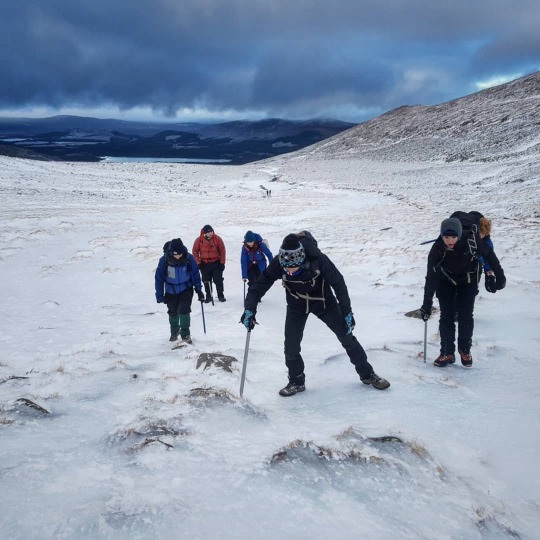
So proud the Climbing Clan Winter Skills practice group in Corrie an t'Sneacha in January: 😯 Fearless Ice Axe Arrest practice 👏 Classy Crampon walking practice 🤩 Confidence in winter skills 📈 Followed by Kirsty's fantastic food this evening! 😝 As my mum said (and she may be biased!): "An pretty intensive (!), but superb weekend at Aviemore ! I learnt and did far more than I expected to do ! Tim and JP (John Proctor) were a great team, teaching and sympathetically encouraging us into the various skills - ice axe usage and crampons (they make a slippery icy surface feel so much more safe), weather watching and snow, ice and brutal winds. If they ever offer this again, go for it ! It's worth the effort. I not competent to go there on my own, yet. But I do now have the confidence in myself, to know that with sympathetic leaders, I can do and enjoy those challenges. And so can any of you !" (at Cairngorm Mountain) https://www.instagram.com/p/B-7GB42jtCw/?igshid=16m0e7z7gkgwd
0 notes
Text
Common Ground
- David M. Watson
Place is timeless—everything else comes and goes. I first found myself in this place, the Scottish highlands, ten years ago. Invited to share my research at a conference in Aberdeen, I made the most of the opportunity and travelled there with my family, staying for a few weeks at a farmhouse on the edge of the Cairngorms National Park. Although we’d never been to Scotland before, so many things were strangely familiar. The honeyed aroma of a peat fire, the scent of heather as we walked up the hill flushing birds new to our eyes but recognized like old friends. The roll of the hills, the lean of the houses, the faces of people we encountered. They looked right; just so. As a Watson, my family roots run deep here. Seven generations of my clan in Australia follow hundreds of generations in this land. The memories are not mine but they resonate as clearly as a curlew at dusk. This was home.
Walking through the heather one morning, I found myself on a sheep trail, my feet gravitating towards the same path as countless before. The path meandered past a dense copse of pines, then turned sharply towards a rivulet, tea-coloured waters sliding across the land. As I turned, my eye was drawn to movement. Looking closely, I saw wire, a cage. Approaching to look more closely, it took me a moment to understand what I was looking at. A raven was caught, flapping wildly at the corners of its jail. It was a crude trap, an opening at the top leading in via a narrowing cone, a dead hare hung as a lure. Integrating this incongruous scene with my experience working on farms and studying birds, I began to understand. Where I live in Australia, many farmers despise crows. Checking on their stock after a cold night to find lambs being picked over by these glossy undertakers, blame comes easy.
Ravens and I have history. Years earlier, I encountered them—this same species, largest of all the songbirds—in the cloud forests of southern Mexico. For my doctoral research, I studied the distribution of birds in these ancient sky islands, trying to fathom how wildlife persists in disrupted landscapes. I presented my interim findings at a conference, right before heading south to visit more forests to add more dots to my graphs, to weave more characters into my story. I met somebody there—we connected straight away. The common ground between us made communicating easy. Days after we met, I was back in the forest. A raven called, off in the distance, its rattling voice filtering though the pines as I was writing a letter to my love. Was this her? Was this my raven?
And here, now, this caged bird. Fiddling with the door, it sprang open. As the bird regarded me, I noted the pink corners to its mouth, the sparse feathers on its throat. This was a young animal, fooled more easily. Seeing the unfettered sky behind me, it flew off, wingbeats pushing away the bracken fronds concealing the wire cage. I watched it shrink into the grey sky and pondered the significance of what had just happened. The intelligence of these birds is legendary. They remember faces, they learn from direct experience and they share knowledge with their kin. I saved a life that day but also informed an extended clan. About small-minded people looking to blame others, about individual actions railing against humanity’s failings. About connections between people and other animals, connections stretching back to a time where the common ground between us made communicating easy.
0 notes
Text
National Trust for Scotland

7 spectacular wedding venues, all with a tale to tell …

Photographer: Samuel Quinn
From fairytale castles, stylish townhouses and elegant stately homes, to landscaped gardens and sprawling estates, each of the National Trust for Scotland’s places has its own fascinating story. If you love Scotland like we do, why not write the latest chapter of your journey together at one of the Trusts spectacular venues? You’ll play a very special part in keeping Scottish heritage alive.
1. Brodie Castle

Photographer: Iain Bain
Surrounded by Moray countryside, this was the home of the Brodie clan for more than 400 years.
Inside, the castle feels decadent and inviting – the perfect romantic atmosphere. The glorious grounds are perfect for marquees, or you can host an intimate dinner in the Dining Room or Drawing Room. Outside the Old Stables are perfect for dining and dancing, but whatever you do, don’t miss the daffodils in spring or the delightful Playful Garden – they’re a wedding photographer’s dream!
2. Mar Lodge Estate

Photographer: Emma Lawson
Built as a Victorian hunting lodge for the Duke and Duchess of Fife in 1895, Mar Lodge sits in the heart of the glorious Cairngorms National Park.
If the weather’s on your side, you could say your vows at the Linn of Dee, one of Queen Victoria’s favourite picnic spots. Or, for a wild indoor celebration, lead your guests to the dramatic Stag Ballroom (which comes complete with Victorian-era stag antlers) and ceilidh the night away. Why not extend your stay with overnight accommodation within the Lodge and wider estate?
3 . Fyvie Castle

Photographer: By Rhea
In the heart of Aberdeenshire, Fyvie Castle is brimming with antiques and priceless artworks that tell the story of this 800-year-old fortress.
With an interconnecting gallery and drawing room, Fyvie makes an ideal wedding venue for larger gatherings. This stunning property also comes with its very own glass-roofed racquets court, where you can celebrate in style and strip the willow on the sprung dance floor. The Preston Tower apartment provides authentic accommodation for up to 13 guests.
4. Hill of Tarvit Mansion

Photographer: Ross Barber
Fans of Downton Abbey will fall in love with this stunning Edwardian home near St Andrews.
Hill of Tarvit Mansion has plenty of unique spaces both upstairs and downstairs, with one highlight being the fabulous Great Hall. Adorned with warm oak panelling and 16th-century Flemish tapestries, it enjoys wonderful views of the Lorimer-designed terraces and gardens.
A marquee on the manicured lawn lets you admire the backdrop of the house as your guests play croquet and sip champagne. They can also get in the swing afterwards with 9 holes on the only hickory golf course in the UK. Fore!
5. Falkland Palace & Garden

Photographer: Eidetic Image Photography
Mary, Queen of Scots was enchanted by this sublime Renaissance palace, which is within easy reach of Edinburgh, Perth and Dundee.
Intimate religious, civil and humanist ceremonies can be held in the Royal Palace, but for larger celebrations there’s the magnificent Oak Lawn, famed for its ‘cathedral’ of oak trees – a truly romantic setting and the place for your wedding photos.
6. Pollok House

Photographer: The Gibsons
This elegant stately home, an oasis of tranquillity just a stone’s throw from Glasgow city centre, is one of the finest in the Trust’s care, and wouldn’t look out of place in a Jane Austen novel.
Filled with elegant art and antiques, the inside of Pollok House is light and luxurious – you can even say your vows in one of the finest 20th-century libraries in Scotland. From there you can open the doors onto a dazzling parterre garden that will set your photographer’s pulse racing.
7. Culzean Castle & Country Park

Photographer: Tommy Cairns
Once the private playground of the 10th Earl of Cassillis, Culzean Castle is a sight for lovestruck eyes! Perched on the dramatic Ayrshire cliffs, and surrounded by acres of woodland, beaches and gardens, it’s filled to the turrets with treasures that tell the stories of the people who lived here.
Choose any kind of wedding you want. If you love luxury, take photos on the famous Oval Staircase. If you want to feel like a VIP, host drinks in the presidential Eisenhower Apartment. If you want to get closer to nature, exchange your vows in the Camellia House or sun-filled Orangery, or hire a marquee or tipee to make the most of the breathtaking grounds and sea views. Party on in the Stone Barn, then stay the night in the Eisenhower Apartment or one of the charming self-catering cottages in the grounds.
There are incredible places of all shapes and sizes in the Trust’s care, and everything they do is for the love of Scotland. By choosing a Trust property for your wedding you can support their vital conservation work.
NTS.org.uk/weddings
Member of www.luxuryscottishwedding.com - Scotland’s Luxury Online Directory for Weddings
#Wedding#wedding venue#castle#luxury Scottish wedding#exclusive venue#history#wedding scotland#scotland
0 notes
Text
Scotland Birds
Now that I’m back from Scotland, here’s a list (for my own reference) of my bird sightings. Maybe these are mundane for UK people, but for an American like me, most of these birds are brand-new!
On the Firth of Forth: We were lucky enough to meet a Derbyshire bloke on the way to the beach who was incredibly knowledgeable about birds. I had the opportunity to ask him about UK birding, and he named some birds for me. I wish I had his contact information. He was very friendly and really knew his stuff! (BONUS: we spent the night in the hometown of John Muir, the father of conservation himself! BONUS AGAIN: Lots of jellyfish got caught in a little harbor area! They were beautiful and unearthly and startlingly blue!)
A couple of blackbirds, nesting in some bushes that lined the path to the shore. They were rather unhappy with us, so we gave them their space.
Some House Martins darting among the rocks on the shore.
Several Gannets flying from Bass Rock, the largest gannet colony on earth! It’s incredibly expensive to go to Bass Rock, though, so we didn’t visit. We did see the island from the shore, though. Its outline was almost completely obscured by birds.
Many Fulmar nesting noisily.
Even more Kittiwakes nesting VERY noisily on the ruined Dunbar Castle.
Some female Eider-Ducks paddling and diving among the ocean waves.
In the Highlands: We stayed near Fort William in a little apartment on Loch Linnhe and spent most of our time hiking. First we explored Rannoch Moor (which was breathtakingly beautiful and empty and vast), then climbed up to Lost Valley (Coire Gabhail), a gorgeous little place where the Clan MacDonald historically hid their rustled cattle. Yes, those are the very same MacDonalds. (BONUS: We spotted a massive Red Deer stag lounging elegantly not too far from the road!)
Some Pied Wagtails, wagging their tails, in each parking lot.
What I think might have been a Hen Harrier, circling above the Rannoch Moor wetlands.
Isle of Skye: We spent most of our time here, and also saw the most new birds. The landscape is breathtaking: my father and I hiked up to the Old Man of Storr, and all four of the family walked the entire length of the Cuirang. There were sheep absolutely everywhere, in the most unlikely of places, and the air constantly rang with their baas. (BONUS: I bought some nice, hand-spun yarn to crochet, and met a very impressive Hebridean black ram!)
A Eurasian Goldfinch, glimpsed briefly from the car, perching in some tall grass.
The roundest, fluffiest Eurasian Wren you’ve ever seen, just sitting and being round and fluffy.
Several Robins perched on the fence at a nearby croft. (European robins aren’t new to me, I met a few - and had some compelling conversations with them - when I visited London.)
A tidy little murder of Jackdaws heckling sheep. (Again, not new to me.)
A handful of Hooded Crows scattered across the island, usually sitting on fenceposts and looking properly ominous. They are very well-practiced in “ominous,” it’s a part they play very well. Good job, crows.
On Neist Point, another colony of Fulmar and Kittiwakes nesting and screaming, but mostly screaming.
At the nesting ground, there were also a pair of snakish Shags...
and several handfuls of black Guillemots, looking very much like penguins (though I did assure my mother that they were not, in fact, actually penguins).
More Pied Wagtails, wagging their tails as always.
Some Starlings, sitting on a sheep’s back. (Starlings themselves are not all that interesting or new, we have enough of them here in the States. I was more intrigued by their odd choice of perch.)
An Osprey, sighted overhead, carrying home a fishy dinner.
The Cairngorms: Rothiemurchus is the region and castle where my family is from. Clan Grant’s a little clan, but we do have a little nature preserve to our name, so we spent a night there to relax and picnic and walk around. It’s a much more wooded area and flatter than Skye or the Highlands. We also stopped at a little cafe on our way there; behind the cafe were a bunch of bird feeders and some songbirds taking advantage. (BONUS: A tiny castle sinking into the lake! BONUS AGAIN: Huge herds of red deer spotted in the highlands on our way down!)
At the feeder, a whole bunch of Siskins eating and arguing. The siskin feeder was right by the cafe window and they didn’t seem to care if a person stood very close. This is probably the closest I’ve gotten to a bird this trip; they were only a few feet away!
A contented Chaffinch hopping on the ground, collecting all the seeds the Siskins dropped.
A Blue Tit joined the Chaffinch for a short time.
In Rothiemurchus Woods, we were serenaded by countless invisible Eurasian Wrens, Robins, and some kind of tit (though I didn’t recognize the exact species by the call.)
Some Magpies, on the lookout for worms and shiny things. (These are not new either; London parks are full of them. They’re still very entertaining, though!)
1 note
·
View note
Text
Adventure #14 - Whorlstone Tunnels
In a strange city of evil deep dwarves who are slowly becoming mad, they only seek a way to the surface but to find it they must satisfy the Flame Keepers’ request to find the derro rogue named Droki so he leads them to where the Gray Ghosts’ lair is and the stolen secret from the Keepers. But before even starting, the group of Caduceus, Aryn, Ikki, Jimjar, Derendil, Stool, Ront, Eldeth, and Eighteen decide to enjoy their first night in many months on a soft warm bed with their bellies full of fresh food and their minds numbed with liquor.
The next morning most of them ache a painful hangover but are still happy to be somewhat free from looking over their shoulders for drow & monsters. Their breakfast is interrupted by a derro boy with a “Candy-Gram.”
“What’s a ... Candy-Gram?” questions Ikki.
The derro smiles with a practically rotted out toothless mouth, “You give candy and I give gram... which is a message...”
So Ikki hands over some candied leeches he’s had since Sloopdulop which the boy licks to prove its sweetness and tells Ikki that the Stone Giants of Cairngorm appreciated their actions in stopping their the two-head giant and more importantly the mercy they showed their brethern who is currently under their care. The derro finishes by telling them that the Stone Giants’ invite them as guests to their fortress and to receive gifts as new friends to Clan Cairngorm.
The group instead decides to focus on their mission for the Keepers to track down this Droki character, and perhaps swing by the Stone Giants’ abode later. So they head out to the East Cleft in the rift dividing the city.
There they discover a jarring difference of lifestyle and architecture between duergar and derro. While the duergar were orderly and had purpose, the derro were chaotic and unpredictable. Shacks made from any materials they could find, grew up and down the cliffs of Laduguer’s Furrow connected with bridges even Ikki felt were dangerous.
Caduceus and Jimjar thought the best place to inquire about Droki would be a gambling hall, so they played some dice games while Jimjar & Eighteen pried information from the gambling derro. Finally after some winning jackpots, they report that Droki is usually in the West Cleft, not the East, so they cash out & give up some more coins to the info providers before booking their taxi back up at the “ground level” of Gracklstugh.
While they could have stopped by the Cairngorm cavern, they are eager to find this Droki and get their reward from the Keepers. In the West Cleft, it is more of the same eclectic mess of shacks build up on top of each other in the cavern valley. Once again they find a gambling den, this time a bingo hall that is true to the derro’s insane nature as the number caller does so in random languages forcing those without the tongue to guess and the others with an advantage.
Aryn, Caduceus, and Ikki put their language knowledge base together while the others join the strange dance floor of 3 different bands playing at the same time. After some games, with Ikki well ahead in coins, Jimjar nudges Aryn to get her attention to the derro that just walked in, a mutton chop bearded derro with patchwork threads and a giant full brimmed hat fringed in random baubles dominated by two stuffed displacer beast tentacles drooped down his neck.
The derro, the know as Droki, makes a quick deal with the bouncer for some coins and leaves quicker then he arrived. The group sprints out to shadow their target but Droki is faster then they anticipated and a spontaneous carnival of derro impedes their path. Ikki flies over, while the others try to bob and weave through the chaos. Ikki struggles to spot Droki, but luckily Aryn easily emerges on the other side of the street party to keep Droki in her sights until the rest catch up. They run down winding streets and in their haste Ikki turns a wrong corner and while on his feet a mad derro stabs him in the back claiming Ikki is a wild turkey that deserves to be in his belly. Caduceus and Ront throw some barrels out of the group’s way while Aryn throws an eldritch blast at the harassing beggar allowing Ikki to escape. Derendil leads them back to Droki’s trail to a purple lit cave in the wall with eerie similar colored fog emerges from a fissure.
Deciding to follow, they drop down into a tunnel leading to a three-way branch, finding strange fungi covered figures in on of the branches they opt for the another where they spot Droki just in time to see him eat a mushroom to turn even smaller to fit into a small crack in the wall! Caduceus looks over the shrooms near the crack and identifies them as pygmywarts and bigmies, one to make you bigger the other to make you smaller. So they all agree to take the pygmywart, and turn to the size of a toddler allowing them to follow Droki into the small crack that leads to a larger tunnel with more stools growing near their exit. Most of them except Ikki take the bigmies to grow back to their normal size but they lose Droki’s trail so they have to guess which way.
1 note
·
View note